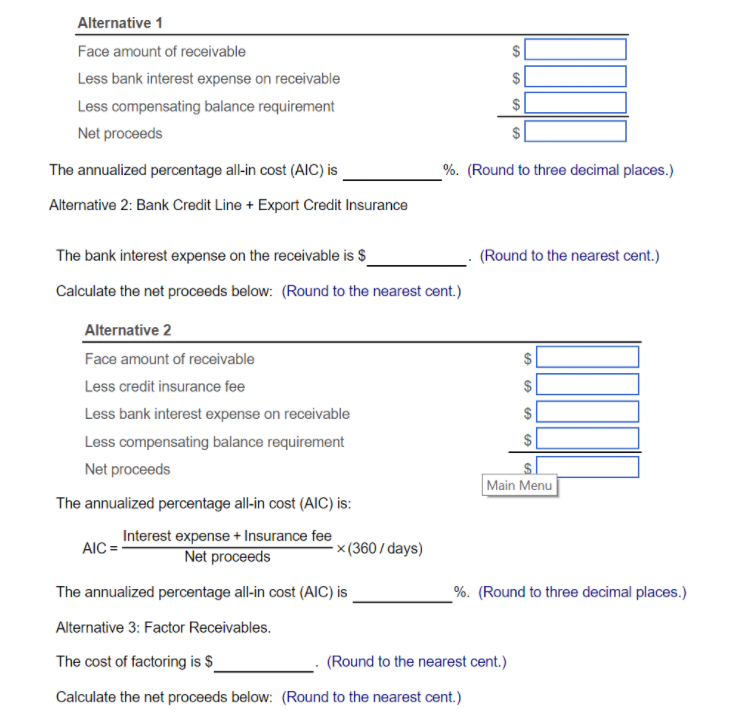


Sunny Coast Enterprises (B). Sunny Coast Enterprises has sold a combination of films and DVDs to Hong Kong Media Incorporated for US$106,000, with payment due in five months. Sunny Coast Enterprises has the following alternatives for financing this receivable: 1) Use its bank credit line. Interest would be at the prime rate of 5.2% plus 150 basis points per annum. 2) Use its bank credit line but purchase export credit insurance for a 1% fee. Because of the reduced risk, the bank interest rate would be reduced to 5.2% per annum without any points. In both cases Sunny Coast would need to maintain a compensating balance of 18% of the loan's face amount, and no interest will be paid on the compensating balance by the bank. 3) Sunny Coast Enterprises has been approached by a factor that offers to purchase the Hong Kong Media Imports receivable at a 16.2% per annum discount plus a 1.9% charge for a non-recourse clause. a. What are the annualized percentage all-in costs of each alternative? b. What are the advantages and disadvantages of the factoring alternative compared to the alternatives 1 and 2. (NOTE: Assume a 360-day year.) . a. What are the annualized percentage all-in costs of each alternative? Alternative 1: Bank Credit Line The bank interest expense on receivable is $. (Round to the nearest cent.) Alternative 1 Face amount of receivable Less bank interest expense on receivable Less compensating balance requirement Net proceeds $ %. (Round to three decimal places.) The annualized percentage all-in cost (AIC) is Alternative 2: Bank Credit Line + Export Credit Insurance (Round to the nearest cent.) The bank interest expense on the receivable is $ Calculate the net proceeds below: (Round to the nearest cent.) $ Alternative 2 Face amount of receivable Less credit insurance fee Less bank interest expense on receivable Less compensating balance requirement Net proceeds Main Menu The annualized percentage all-in cost (AIC) is: Interest expense + Insurance fee AIC = Net proceeds -x (360 / days) The annualized percentage all-in cost (AIC) is %. (Round to three decimal places.) Alternative 3: Factor Receivables. The cost of factoring is $ (Round to the nearest cent.) Calculate the net proceeds below: (Round to the nearest cent.) $ Alternative 3 Face amount of receivable Less cost of factoring, discount rate Less non-recourse clause Net proceeds The annualized percentage all-in cost (AIC) is %. (Round to three decimal places.) b. What are the advantages and disadvantages of the factoring alternative compared to the alternatives 1 and 2. (Select all the choices that apply. A. Although the costs of factoring are clearly higher than using bank credit lines, factoring removes the receivable from the balance sheet, both as an asset and the associated debt to finance it using the bank credit line. B. Although the costs of factoring are clearly lower than using bank credit lines, factoring reduces the company's bank credit line and punishes the company's bottom line unnecessarily. C. Factoring requires expending the cash at the start of the time period compared instead of waiting six months later under the bank credit line. D. Factoring also provides the cash at the start of the time period compared to waiting six months later under the bank credit line









